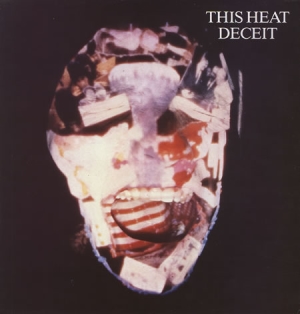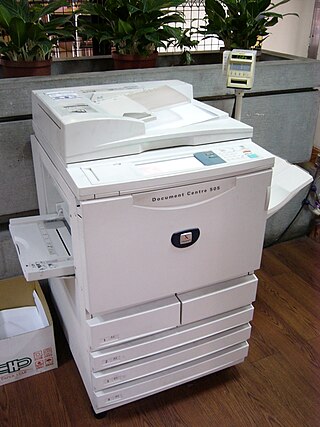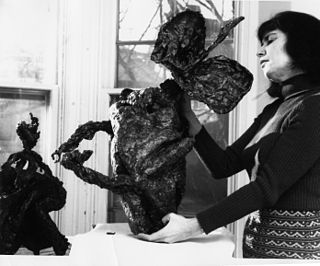Related Research Articles

Kenneth Noland was an American painter. He was one of the best-known American color field painters, although in the 1950s he was thought of as an abstract expressionist and in the early 1960s he was thought of as a minimalist painter. Noland helped establish the Washington Color School movement. In 1977, he was honored with a major retrospective at the Solomon R. Guggenheim Museum in New York that then traveled to the Hirshhorn Museum and Sculpture Garden in Washington, D.C., and Ohio's Toledo Museum of Art in 1978. In 2006, Noland's Stripe Paintings were exhibited at the Tate in London.

Laser printing is an electrostatic digital printing process. It produces high-quality text and graphics by repeatedly passing a laser beam back and forth over a negatively charged cylinder called a "drum" to define a differentially charged image. The drum then selectively collects electrically charged powdered ink (toner), and transfers the image to paper, which is then heated to permanently fuse the text, imagery, or both, to the paper. As with digital photocopiers, laser printers employ a xerographic printing process. Laser printing differs from traditional xerography as implemented in analog photocopiers in that in the latter, the image is formed by reflecting light off an existing document onto the exposed drum.

Op art, short for optical art, is a style of visual art that uses optical illusions.

Abstract art uses visual language of shape, form, color and line to create a composition which may exist with a degree of independence from visual references in the world.
Xerox art is an art form that began in the 1960s. Prints are created by putting objects on the glass, or platen, of a copying machine and by pressing "start" to produce an image. If the object is not flat, or the cover does not totally cover the object, or the object is moved, the resulting image is distorted in some way. The curvature of the object, the amount of light that reaches the image surface, and the distance of the cover from the glass, all affect the final image. Often, with proper manipulation, rather ghostly images can be made. Basic techniques include: Direct Imaging, the copying of items placed on the platen ; Still Life Collage, a variation of direct imaging with items placed on the platen in a collage format focused on what is in the foreground/background; Overprinting, the technique of constructing layers of information, one over the previous, by printing onto the same sheet of paper more than once; Copy Overlay, a technique of working with or interfering in the color separation mechanism of a color copier; Colorizing, vary color density and hue by adjusting the exposure and color balance controls; Degeneration is a copy of a copy degrading the image as successive copies are made; Copy Motion, the creation of effects by moving an item or image on the platen during the scanning process. Each machine also creates different effects.

Josef Albers was a German-born American artist and educator who is considered one of the most influential 20th-century art teachers in the United States. Born in 1888 in Bottrop, Westphalia, Germany, into a Roman Catholic family with a background in craftsmanship, Albers received practical training in diverse skills like engraving glass, plumbing, and wiring during his childhood. He later worked as a schoolteacher from 1908 to 1913 and received his first public commission in 1918 and moved to Munich in 1919.
Chester Floyd Carlson was an American physicist, inventor, and patent attorney born in Seattle, Washington.

Xerography is a dry photocopying technique. Originally called electrophotography, it was renamed xerography—from the Greek roots ξηρόςxeros, meaning "dry" and -γραφία-graphia, meaning "writing"—to emphasize that unlike reproduction techniques then in use such as cyanotype, the process of xerography used no liquid chemicals.

The Museum of Printing (MoP), located in Haverhill, Massachusetts, is a museum dedicated to preserving the history of printing technologies and practices, the graphic arts, and their role in the development of culture and literacy.

Anni Albers was a German textile artist and printmaker credited with blurring the lines between traditional craft and art.
Besides surface qualities, such as rough and smooth, dull and shiny, hard and soft, textiles also includes colour, and, as the dominating element, texture, which is the result of the construction of weaves. Like any craft it may end in producing useful objects, or it may rise to the level of art.

Günther Förg was a German painter, graphic designer, sculptor and photographer. His abstract style was influenced by American abstract painting.

Deceit is the second and final studio album by English experimental rock band This Heat, released in September 1981 by Rough Trade Records. As with their self-titled debut album, the tracks on Deceit were assembled from largely improvised recordings that the band accumulated since their inception in 1976, with varying degrees of audio quality. However, it is generally considered to be more song-oriented than its largely abstract predecessor. The title is in part a pun on the band's name.
Adam Ant is a British post-punk, new wave artist. He was the lead singer of Adam & the Ants until their split in early 1982, by which time they had recorded three studio albums. Ant, however, would go solo, and release an additional five studio albums throughout the 1980s and early 1990s. After a gap of nearly 18 years, his sixth released solo studio album came out in early 2013. A planned follow-up album recorded the following year currently officially remains at developmental stage.

A photocopier is a machine that makes copies of documents and other visual images onto paper or plastic film quickly and cheaply. Most modern photocopiers use a technology called xerography, a dry process that uses electrostatic charges on a light-sensitive photoreceptor to first attract and then transfer toner particles onto paper in the form of an image. The toner is then fused onto the paper using heat, pressure, or a combination of both. Copiers can also use other technologies, such as inkjet, but xerography is standard for office copying.
Leah Dickerman is the director of research programs at The Museum of Modern Art in New York City. She was formerly director of editorial & content strategy at MoMA. Serving previously as the museum’s first Marlene Hess Curator of Painting and Sculpture, a post endowed in 2015, Dickerman previously held the positions of curator of painting and sculpture at MoMA (2008–2015), acting head of the Department of Modern and Contemporary Art at the National Gallery of Art (NGA), Washington, D.C. (2007), and associate curator in modern and contemporary art at the NGA (2001–2007). Over the course of her career, Dickerman has organized or co-organized a series of exhibitions including One-Way Ticket: Jacob Lawrence's Migration Series and Other Works (2015), Inventing Abstraction, 1910-1925 (2012–2013), Diego Rivera: Murals for the Museum of Modern Art (2011–2012), Bauhaus: Workshops for Modernity (2009–2010), Dada (2005–2006), and Aleksandr Rodchenko (1998).

Sarah Jeanette Jackson, was an American-Canadian artist. Jackson first became known for her sculptures and drawings, and then for her photocopy and digital art. She was an early user of the photocopier to make art, and used this practice to embrace mail art.
Louise Odes Neaderland is an American photographer, printmaker, book artist and founder of the International Society of Copier Artists (I.S.C.A.) and the I.S.C.A. Quarterly, a collaborative mail, book art, and copy art publication. She was the organizer of ISCAGRAPHICS, a traveling exhibition of xerographic art.
Generative Systems was a program founded by Sonia Landy Sheridan at the School of the Art Institute of Chicago in 1969 to help integrate art with new technologies.

Klaus Urbons is a German photographer and xerography printmaker. He is a pioneer and leading figure of copy art in Germany and not only. He founded the Museum für Fotokopie, and is the author and translator of books on the history of Copy Art and photocopiers, as well as a curator and a collector.

Gen Atem is a visual and performance artist, musician, writer, and Zen-master. He lives and works in Zurich, Switzerland.
References
- 1 2 "Laurie Rae Chamberlain". National Gallery of Australia. Retrieved 2023-02-03.
- 1 2 Walker, John A. (2006). "Copy This! A Historical Perspective On the Use of the Photocopier in Art" (PDF). Plagiary: Cross-Disciplinary Studies in Plagiarism, Fabrication, and Falsification: 22–24.
- 1 2 "Laurie-Rae Chamberlain". British Museum. Retrieved 2023-02-06.
- 1 2 3 4 5 Mulholland, Neil (2017). The cultural devolution : art in Britain in the late twentieth century (1st ed.). London. ISBN 978-1-315-19831-6. OCLC 1003888943.
{{cite book}}: CS1 maint: location missing publisher (link) - ↑ Chamberlain, Laurie (1982). "cover xerography". New Scientist. 94 (1301): cover – via Google Books.
- 1 2 Snapes, Laura (2016-07-14). "No One's More Punk than Vivien Goldman". Pitchfork. Retrieved 2023-02-06.
- ↑ Rose, Cynthia (1999-10-21). "British Talent On Display At New Houston Gallery". The Seattle Times. Retrieved 2023-02-07.
- ↑ POELL (1992). Entwürfe Für Den Alltag Typografie Grafik-Design Art Direction (in German). Basel: Springer Basel AG. p. 170. ISBN 978-3-0348-6211-0. OCLC 1250076240.
- ↑ "Record shot from Laurie Rae Chamberlain exhibition at Institute of Contemporary Art, London, 1978., I.C.A., 12 July - 6 August 1978". Tate Images. Retrieved 2023-02-06.
- ↑ BBC Archive (2017-11-29). "#OTD 1982: Laurie Rae Chamberlain demonstrated xerography art (made using a photocopier) to Nicky Picasso, on Riverside". Twitter. Retrieved 2023-02-06.
- ↑ Januszczak, Waldemar (1982). "Zen and the Art of Color Xerography". New Scientist. 96 (1334): 590 – via Google Books.
- ↑ Nairne, Eleanor (2014-01-03). "Xerography". Frieze. No. 160. ISSN 0962-0672 . Retrieved 2023-02-03.
- ↑ "The Secret Role That Copy Machines Have Played In Modern Art". Gizmodo Australia. 2013-09-13. Retrieved 2023-02-03.
- ↑ "Group Show "Still Undead: Popular Culture in Britain Beyond the Bauhaus" with Stephen Willats". Galerie Elisabeth & Reinhard Hauff. Retrieved 2023-02-06.
- ↑ "Still Undead: Popular Culture in Britain Beyond the Bauhaus". www.nottinghamcontemporary.org. Retrieved 2023-02-06.
- ↑ "Object: Year of the Diamond". The British Museum. Retrieved 2023-02-03.
- ↑ "Going on the First Train Tomorrow | Chamberlain". Victoria and Albert Museum: Explore the Collections. 1979. Retrieved 2023-02-06.
- ↑ Hamsley, David (2015). To disco, with love : the records that defined an era. New York. p. 170. ISBN 978-1-250-06845-3. OCLC 898419060.
{{cite book}}: CS1 maint: location missing publisher (link) - ↑ Apilianty, Neny; Ramadhan, Mochammad Sigit (2018-12-01). "Pengaplikasian Teknik Xerography Image Transfer Pada Material Tekstil". EProceedings of Art & Design (in Indonesian). 5 (3). doi:10.25124/eoe.v5i3.7847 (inactive 31 January 2024). ISSN 2355-9349.
{{cite journal}}: CS1 maint: DOI inactive as of January 2024 (link) - ↑ Breznikar, Klemen (2019-03-29). "This Heat interview Charles Hayward". It's Psychedelic Baby Magazine. Retrieved 2023-02-06.
- ↑ Cuzner, Russell (2016-02-02). "Why Study Art When You Can Make It: The Strange World Of… This Heat". The Quietus. Retrieved 2023-02-06.